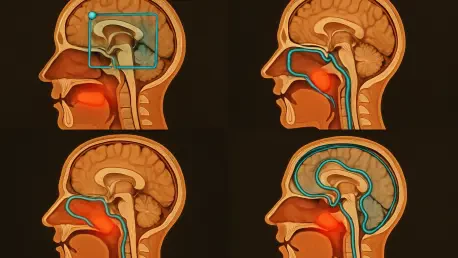Imagine a scenario where a patient struggles to breathe, plagued by persistent coughing and choking, yet standard medical imaging fails to reveal the cause—a foreign object silently lodged in their airway, posing a life-threatening risk. Such cases of foreign body aspiration (FBA), particularly involving radiolucent objects that are nearly invisible on scans, pose a significant diagnostic challenge, often leading to delayed or missed diagnoses in up to 75% of adult cases. A groundbreaking study from the University of Southampton, in collaboration with researchers from Wuhan, China, has introduced a promising solution through artificial intelligence (AI). Published in a leading medical journal, this research showcases an AI tool that surpasses experienced radiologists in detecting these elusive blockages in CT scans. This development marks a potential turning point in managing life-threatening airway conditions, offering hope for faster and more accurate diagnoses.
Revolutionizing Medical Diagnostics with AI
Tackling the Challenge of Invisible Threats
Detecting foreign body aspiration, especially when the obstructing object is radiolucent—such as plant material or certain shells—remains one of the toughest hurdles in medical imaging. These materials often evade detection on X-rays and appear faint even on advanced CT scans, leaving clinicians grappling with uncertainty. The consequences of missing such blockages can be dire, ranging from chronic respiratory issues to acute emergencies. The recent study highlights how an innovative AI model, developed through a deep learning approach, addresses this gap. By employing a high-precision airway mapping technique known as MedpSeg alongside a sophisticated neural network, the tool meticulously analyzes CT images for subtle anomalies that human eyes might overlook. This technology acts as a critical support system, enhancing the ability to spot hidden dangers and potentially reducing the alarming rate of missed diagnoses that jeopardize patient health.
Enhancing Precision Through Technology
Beyond merely identifying a problem, the AI system offers a measurable improvement in diagnostic precision, as demonstrated in rigorous testing. The model was evaluated on over 400 patients across multiple groups, with a specific focus on 70 CT scans, 14 of which involved confirmed cases of radiolucent FBA. While expert radiologists achieved flawless precision by avoiding false positives, they detected only 36% of these challenging cases—a testament to the difficulty of the task. In stark contrast, the AI identified 71% of cases, though with a precision rate of 77% due to occasional false positives. Its overall effectiveness, captured by an F1 score of 74% compared to the radiologists’ 53%, underscores a significant leap forward. This advancement suggests that integrating AI into clinical workflows could dramatically lower the risk of oversight, ensuring that more patients receive timely interventions for potentially life-threatening conditions.
Future Implications and Collaborative Efforts
Building Confidence in Clinical Settings
The potential of AI to transform the diagnosis of complex conditions like FBA extends beyond raw performance metrics to its role as a collaborative tool in healthcare. Researchers emphasize that this technology is not designed to replace radiologists but to serve as an additional layer of assurance, particularly in ambiguous or challenging cases. By acting as a second set of eyes, the AI model boosts confidence in diagnostic decisions, allowing medical professionals to focus on patient care while leveraging technological support. This balanced integration reflects a broader understanding of AI’s place in medicine—acknowledging its strengths in pattern recognition while respecting the irreplaceable value of human expertise. As this tool becomes refined, it could redefine how clinicians approach airway blockages, ensuring that even the most subtle signs are not missed in critical moments of patient evaluation.
Expanding Research for Broader Impact
Looking ahead, the research team behind this AI innovation is committed to expanding the scope of their work to ensure its applicability across diverse populations. Plans are underway for multi-center studies involving larger and more varied patient groups, a step aimed at minimizing any risk of bias in the model’s performance. This focus on inclusivity is crucial for adapting the technology to different healthcare environments and demographic profiles worldwide. By addressing these variables, the goal is to create a robust diagnostic aid that can be seamlessly integrated into various clinical settings, from urban hospitals to remote facilities. The ongoing efforts signal a proactive approach to refining AI capabilities, with an eye toward saving lives through earlier and more reliable detection of airway obstructions. Such advancements, built on collaborative international research, pave the way for a future where technology and medicine work hand in hand to tackle some of the most elusive health challenges.
Reflecting on a Milestone in Medical Imaging
The study conducted by the University of Southampton and its collaborators stands as a pivotal moment in the journey of AI within medical diagnostics. It showcased how a carefully designed AI model outpaced human radiologists in identifying hidden airway blockages caused by foreign body aspiration, marking a significant stride in addressing a notoriously difficult condition. The technology proved its worth by enhancing detection rates, offering a lifeline to patients who might otherwise have faced delayed care. While it complemented rather than supplanted clinical expertise, its role as a supportive tool reshaped approaches to challenging diagnoses. As the research team pursues broader studies to refine and adapt this innovation, the path forward becomes clear: continued collaboration and rigorous testing are essential to ensure this AI solution meets global healthcare needs, ultimately transforming patient outcomes in profound ways.









